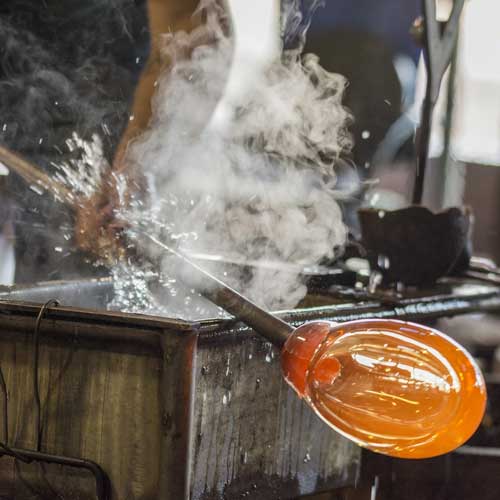Everything You Need To Know About Glass Lighting

Lighting and glass go together perfectly, with endless variations, utmost unique designs and eye-catching finishes. Glass lighting exudes an artisan process, with meticulous craftsmanship from piece to piece. It is no wonder that glass lighting is popular amongst interior designers and homeowners.
Here at Fat Shack Vintage, our glass lights and shades are created using traditional forms of glassmaking. These are hand blown and machine pressed from around the world, making their way into your living space to be cherished for years to come. Below, we will take you through the process of creating glass lighting and highlight the different results that you will find when looking at glass lighting.
The Process: Hand Blown Glass

Product in image is Boston Schoolhouse Pendant Light.
This is the most artistic and ancient process in creating glass. From a technical standpoint, the method involves using a blowpipe to blow/puff short amounts of air into the hot molten section of a glass. The outcome is a formation of an adaptable skin of glass that a glassmaker can inflate and work into a desired shape. This meticulous process gives the glassmaker limitless creative control by rotating the blowpipe, manipulating temperature and forming complex shapes. This method perfectly exemplifies the artistic and craftsman like process in hand blown glass making
The Process: Pressed and Machine-Made Glass

Product in image is the Como Glass Pendant Light.
The second most useful way of creating glass lighting is via machine pressed or mould glass making. This method is like the hand-blown glass technique, were a blowpipe is used to form glass shapes, but instead of completely free hand techniques, a premade mould is used for the intricate details. This premade mould determines the design and shape of the glass vessel being created. The use of a premade mould means glassmakers also can mass produce glassware and objects via machine pressing. This process entails similarity to a factory line, where products are produced on a larger scale.
The Results: Hand Blown Glass
The process of handblown glass making creates a unique finish and final product for each piece and glass shade is therefore unique. Markings, air bubbles and irregularities on the final piece are not considered defects but are a way to identify this artistic process of hand blowing glass. This also means that no two hand blown glass shades are ever the same, with slight differences from piece to piece adding an artisan quality.

Products in image are (left to right): Glass Ball Pendant Light, Carlyle Schoolhouse Ceiling Light, Chelsea Schoolhouse Chain Pendant Light.
The Schoolhouse Light Shades display this process perfectly. Based upon old lighting fixtures once found in schools, libraries and courthouses, these lights feature traditional glass making designs; smooth opaque glass, artistic edging and cornering and a historic allure. These glass shades are mouth blown and cut by hand, with each piece unique from the last. Each glass shade design is made via the same process but can differ vastly in style. For example, Schoolhouse Pendants offer a bowl-shaped shade with smooth organic lines. Whereas the eye-catching Astor Pendant Light reflects a period Art Deco flair, with strong defined lines in a tiered downward shade.
The Results: Pressed and Machine-Made Glass
Pressed or machine-made glass can replicate a hand-blown glass look, using a predetermined mould. The results are like that of hand-blown glass but can be mass produced. This process is a cost effect and efficient and does not compromise on style and quality.

Products in image are (left to right): Apsley Glass Pendant Light, Crosshatch Glass Pendant Light, Como Glass Pendant Light.
A fitting example of pressed glass lighting is our Como range of lighting. The glass has been machine pressed, with a classic appeal and timeless style of ribbed glass etching and a clear finish. This showcases the detail you can find in mould made glass lighting. Likewise, the Plymouth or Apsley glass shades exhibit this process but shows how different designs can be formed. These timeless lights have been created to replicate early 20th Century lighting, where glass shades had a boost in popularity. The moulded holophane style reflects not only old-styled designs, but also classic glass making techniques.
Looking for more types of glass lighting? Explore our full range of Pendant Lights and Wall Lights. Or you can browse our range of decorative lighting.
For more inspiration, be sure to follow and check out our Pinterest below!

















































